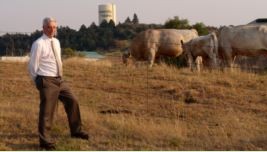VOA慢速英语:Improving 'Feed Efficiency' in Cattle
From VOA Learning English, this is the Agriculture Report in Special English.
Animal feed is the biggest cost for most cattle producers. In the United States, the cost of hay, grains and other feed has risen sharply because of a drought. At the same time, wildfires this year burned more than a million hectares of North American rangeland.
Jack Field raises cattle in the northwestern state of Washington. To save money, he made plans to truck his small herd of cows three hundred kilometers to feed on crop stubble. Crop stubble is what remains after crops have been harvested.
 University of Idaho Professor Rod Hill with part of the university's purebred herd (VOA/T. Banse)
University of Idaho Professor Rod Hill with part of the university's purebred herd (VOA/T. Banse)
Moving his cattle from farm to farm costs money and time. But he says if he can avoid feeding them hay, he can still make a profit.
Tim DelCurto is a beef scientist at Oregon State University. He is working with ranchers and feedlot owners to help them find lower cost ways to feed cattle. He says cattle can eat things like grass-seed straw and distillers grains. These grains are left over from ethanol fuel production.
He says cattle can also eat cannery waste and items rejected by vegetable processors -- like misshapen green beans, carrots, even French fries.
"Now I think one of the unique attributes of beef cattle -- and sheep would fit this, too -- is that they can virtually digest anything."
The rising cost of feed has led agricultural research universities to give greater attention to what experts call "feed efficiency." The University of Idaho has a cattle barn where sensors measure exactly how much food each cow eats.
Professor Rod Hill says just because animals are growing at the same rate does not mean they eat the same amount of food. In fact the difference in how efficiently their bodies convert feed into meat, fat, bone and hide might be surprising.
"These animals are -- for your eye and mine -- they look quite homogenous. But the variation in intake for animals growing at the same rate is of the order of thirty-five percent."
This is a case where humans and animals have something in common.
"You know, we talk to people who say, 'All I have to do is, is, is look at the candy store and, and I put on three pounds.' And so we don't actually quantify it so precisely in humans, we know in humans that some people can eat a little and they can put on quite a bit of weight and some people can eat a lot and hardly put on any weight. So it's a biological phenomenon."
Rod Hill says ranchers can use selective breeding to get the same growth with less feed. But he says not to focus too much on one thing, like reducing fat.
"Less-efficient animals are slightly fatter, and more-efficient animals are slightly leaner. So we wouldn't want to just go after efficiency and then forget about the body composition. So, we wouldn't want animals to become too lean, so that might reduce marbling in the product, especially in the quality cuts where the profit is."
- 频道推荐
- |
- 全站推荐
- 推荐下载
- 网站推荐




















